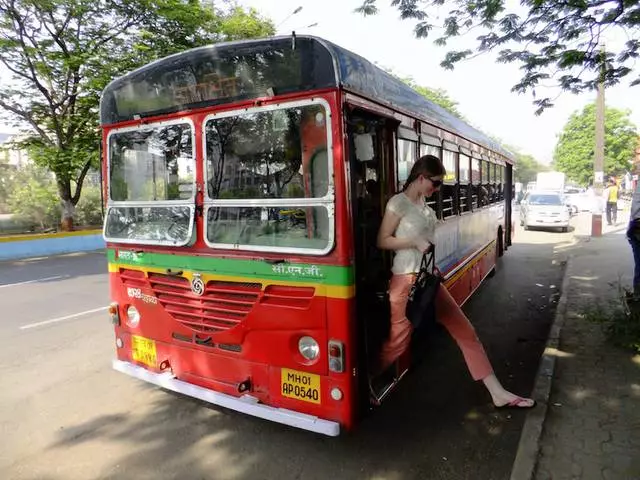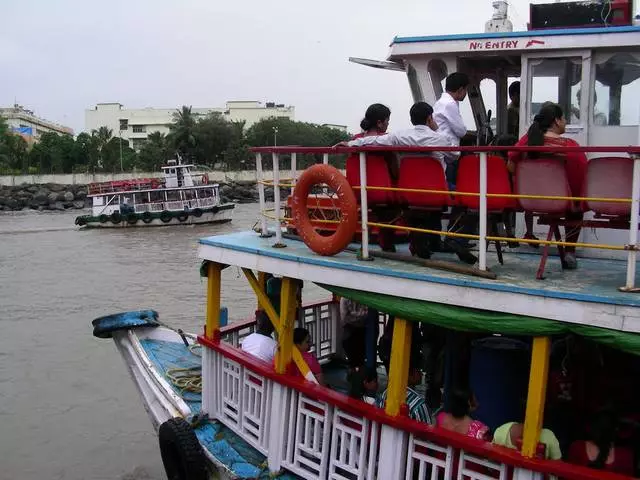In such a big city, it is not possible not to be a developed system of transport links: even if it is not so perfect, as we used to, but quite suitable for movement. In Mumbai, it Rickshaw, taxi, buses, suburban trains and water transport.
Buses
Such public transport in Mumbai has been working for a long time - from 1926 (then the city was also called Bombay). From 1937, two-storey buses began to appear on the routes. Transportation management is mainly carried out by Best. Types of buses are somewhat, about them further.
On the usual route number is indicated by white numbers on a black background - it stops at all stops; on the "limited" - the red number, and at the end there is a LTD prefix, such a bus stops only at the main stops; Special has a number-white, background-red, after the number - the SPL prefix, such a transport goes in the city center; On express, the number is printed in red on the yellow background, after - the letters C and EXP. If the express is equipped with air conditioning, then the room is written in black on the yellow, the console is the letters A and EXP, these buses drive from the center of the outskirts; Those buses that are sent to the port are indicated except the route number, additional inscription: "Port Ferry".

You can buy a ticket for one trip - right in transport. Its cost will depend on the distance. More on buses and suburban electric trains, you can use the Go Mumbai travel card: it is remote and zonal. Remote, designed for use within a month costs 220 rupees (2 km per day) or 880 (20 km per day). Zonal are nine different types, the cost of cards ranges from 250 to 2545 rupees per month - it depends on how many routes are covered by a specific type of cards. In addition to all described, there is another RFID card that is possible to replenish.
Taxi
Mumbai taxi cars travel around many. If we talk about the central part of the city - it is mainly old cars painted in black and yellow. Local taxi companies can be public or privately owned. Counters installed on licensed cars. You can find the car on the streets of the city or call from your hotel. The price of travel must be specified before landing in the car. Usually, for the first 1.6 kilometers, 16 rupees are paid, for each subsequent km - 10. At night, the tariffs are more - from midnight to five in the morning the counter of the counter increases in 1.25 p.
Motorikshi.
It is difficult to imagine Mumbai without these guys. They are allowed to ride everywhere, the exception is only the historic center of the city. Usually, there are meters on such motorcycles with passenger wheelchairs, but when you sit in transport, check whether the drivers reset the testimony of the instrument. About the price: as an example, we can say that travel on the route "Victoria Station" - Kolaab district will cost you approximately in hundreds of rupees.

Water types of transport
The city of Mumbai is the largest international goal of the country. Through the port of Javaharlal, Nehru in our time passes up to sixty percent of all container cargo in India. There are eight ferry ports: Elephanta Ferry, Ferry Wharf, Marve Jetty, Madh Jetty, Versova Jetty, Manori Jetty, Pirpau Jetty and Gorai Ferry.
Here are ferry routes operating in the city:
The first: "The gate to India is the cave of Elefanta," is the only option to get into the caves.
Second: "Marve Jetty (Malad) - Manori Jetty," with the help of it, a message is made between the two shores in the Manori bay.
Third: "Versova - Madh Jetty", with which there is a message between the shores in the Bay of Mlad.
Fourth: "Gorai (Borivali) - Gorai Beach", with its help the shores in the Gulf of Manory in its northern part are communicated, and in addition, through it - the shortest road to the water park and the ESSELWORLD amusement park.

Ferry shipments manage private companies PNP Maritime Services, Ajanta Catamarans, Maldar Catamarans and others.
The visitors often love to order water walks along the harbor - for these purposes, a boat or a motorboat is used. Such a good option to get acquainted with Mumbam from the new angle. Usually, the cruise lasts half an hour and costs forty-fifty rupees. Walking are organized throughout the year, the exception is only the Mussian period (June-September).
Railway communication
Mumbai is also a major railway node, it is from this city that passenger transportation began in Asia: the first railway was laid between the settlements of Mumbai and Thany. It happened in 1853.
Nowadays, you can get to any corner of the state: from the south, the East and the North, the compositions come to Mumbai at Chattrapati Shivaji Terminus (or Victoria Terminus, VT) and Dadar Terminus, from Rajastana and other seats of North - to Mumbai Central Trains And Bandra. In addition, there is a message between Maharashtra and Goa - on the new Konkan Railway line.
Locals are often moving on suburban electric trains, as in city transport. In this composition, usually nine, twelve or fifteen wagons. In the city railway system there are three branches - Western, to which thirty-six stations on the west coast; Central - on it twenty-four stations; The port - goes first next to the bay, and after - under it on a two-kilometer tunnel. And the fourth, trans-port is built, some of them were commissioned ten years ago.
In the electric trains there are two classes of cars - the first and second. For travel in the first grade, you often have to pay several times more than in the second. There are still separate "female" cars, as well as intended for people with disabilities, and mixed tags. The ticket can be bought at the box office or in an automatic machine to any of the stations. For the convenience of tourists, individual cash registers are organized for them - so that they do not lose time with all the queues. By the way, at such a cashier you can buy not only a one-time ticket, but also a special travel, calculated for the guests of the city - it is designed for a day, three and five, and also - for a month, for three, for a year and without a temporary limit.
